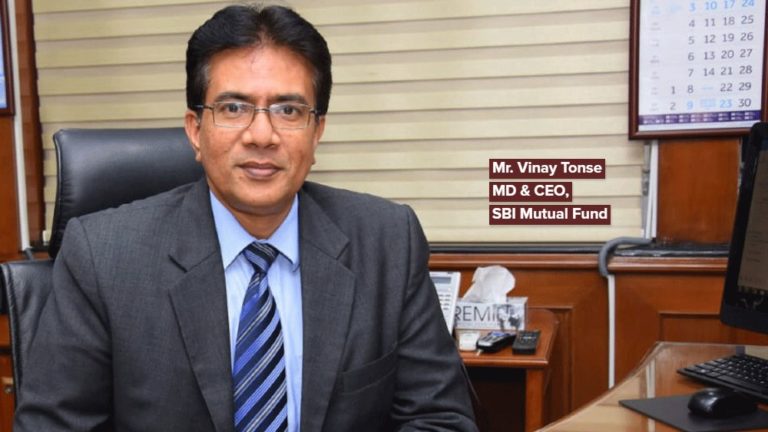SBI Mutual Fund became the first and only fund house in India to cross Rs 4 lakh crore of AUM. The last released data shows that as of November 2020 its AUM is at Rs 4.67 lakh crore. Although SBI is a big brand, has a great legacy yet this is a big achievement. Indian Economy & Market decided to piece together the past and the future initiatives of the fund house and Shri Vinay M Tonse, Managing Director & Chief Executive Officer obliged even though he took the reigns just four months back. Over his tenure of 32 years with the State Bank of India, he has traversed through various functions and assignments including foreign assignments as head of the operations at Japan as CEO.
November is yet another month when we have witnessed a continuous net outflow from equity dedicated funds. What is your view on such moderation in inflows and when can we expect equity investors coming back?
This year has seen unprecedented volatility, having touched multi-year lows at the beginning of the year, when the pandemic had just started gathering pace, and now is at record highs when the first of the anti-Covid vaccines are ready for a roll-out. As we have seen before, whenever equity markets rise and touch fresh highs, investors scurry to try and book profits at those levels. What we are seeing in equity-dedicated funds is also the same rush for profit booking. This is not necessarily a severe moderation in inflows, as much as an unusual increase in outflows.
Our sense is that with markets at these levels most of the profit-booking is already behind us and outflows from hereon should start to taper. Over the years, we have seen a certain maturity on the part of investors who have now started to understand the concept of buying low and selling high, and that profit-booking should be followed by re-entry into the markets. So, we believe that investors will soon start to make their way back towards equity mutual funds.
SBI Mutual Fund becomes the first fund house in India to cross Rs 4 lakh crore of AUM. What is your take on this?
Of course, it is a proud moment for us and an important milestone as a fund house. But this is not just about the AUM. At the end of the day, our endeavor is to reach out to as large an investor base as possible. In fact, one of the reasons we have been able to get to the Rs 4 lakh crore-mark (as of Sept 2020 our quarterly average AUM is Rs 4.21 lakh crore) has been because of our strong distribution network, a part of which can be attributed to the legacy, brand, and the good-will of our parent. This was ably supported by our digital infrastructure which made it possible for us to bring into our fold those investors who are digitally abled and prefer the ease of online transactions. Our goal is to be the asset manager to every Indian and to get there we need to focus on expanding our presence beyond the tier-I, tier-II cities and reach those in the remote parts of the country.
Do you think that compliance of SBI Funds Management with the Global Investment Performance Standards has helped it to garner more AUM?
The GIPS is a voluntary performance reporting standard that we have adopted in our aim to be completely transparent and add value to our investors and stakeholders. This does not directly impact our AUM growth but yes, it does reflect upon our commitment towards investor centricity by adhering to the highest standards of ethical and professional conduct. Being a GIPS compliant entity for the last two years is one of the initiatives we have taken towards adopting the best business practices being followed around the world.
How the departure of the top-level executives from SBI MF will impact the overall performance of the funds
We believe it is collectively the people in an organisation, not an individual or a group of people, and processes that support them that define a business. For every organization to function smoothly, you need people and processes to be in-sync with each other. We can’t have one without the other. So, when you ask how the departure of a top-level executive will impact the overall performance of the funds, then you are only focusing on the ‘people’ part and ignoring the ‘process’ part.
To answer your question – there will be no impact on the performance of the fund because, on an organizational front, we have always had strong internal processes and structures. Over the years, we have created robust investment frameworks by incorporating best practices which includes a well-defined risk management process that helps in continuous monitoring of portfolios, maintaining internal limits, consistency in investment strategy, ensuring regulatory compliance at all times, among others. Moreover, we have an investment team that functionally has a flat structure that enables a free flow of knowledge across analysts, economists, quant analysts, and fund managers. Therefore, with such a robust system in place, we don’t see any impact on the performance of our funds.
Also, our partnership with Amundi has been of great value to us in this pursuit as their expertise aids us in seamlessly aligning these processes with global best practices.
We have seen a trend where a lot of index funds and ETFs are getting launched. How do you look at the future of index investing, and do you see opportunities in this space?
To some extent, the increase in passive funds such as index funds and ETFs can also be seen as a direct result of the SEBI re-categorization exercise which came into effect in 2018. The new categorization classified index funds and ETFs as a separate category which brought them to the fore of investor curiosity. While ETFs and index funds have been around for a long time, the past few years have seen a resurgence in demand for these products as our markets and the mutual fund industry have matured and evolved, expanding beyond offerings within the active funds’ space.
Having said that let me also point out those active mutual funds will continue to hold sway among investors as long as there are opportunities for significant alpha-generation in these funds. But investors are getting more sophisticated in their understanding of products. We now have a group of investors who are willing to look at passive funds which are low-risk, low-cost investment solutions, as complementary solutions to their existing basket of active mutual funds. Going forward, we believe that passive investing is set to garner a larger market share of the industry and of investor wallets. The demand for passive investing will continue to grow stronger over the coming years.
The equity market is currently trading at its lifetime high, what will be your advice to retail investors at the current juncture?
Our advice to investors is to stay invested at all times. Equity markets are flirting with lifetime highs, but even at this juncture, there are opportunities in the market. Finding those opportunities is what mutual funds do best. So, to beat this volatility, both in equity and debt markets, we would encourage investors to enter the markets or continue participating. If investors are wary of investing large sums at these market levels, then they can choose to invest in a staggered manner via SIPs. In the last one-year period particularly, we have been encouraging investors to do SIPs in debt mutual funds as well to better manage volatility.






















